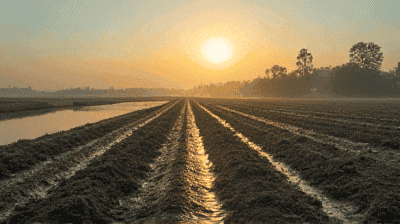
Heavy metal contamination of farmland is a growing concern in many regions around the world. With increasing industrialization, urbanization, and agricultural practices, soils are often polluted with metals such as lead, cadmium, arsenic, mercury, and chromium. These contaminants can have severe long-term effects on soil health, crop quality, and human health, leading to a wide array of ecological and economic repercussions.
Heavy metals are defined as metallic elements with high atomic weights and densities that are toxic or poisonous at low concentrations. Common heavy metals include:
Lead (Pb): Found in batteries, paints, and plumbing systems; it can enter soil from industrial emissions or leaded gasoline.
Cadmium (Cd): Often associated with fertilizers and industrial processes, cadmium can accumulate in soils and enter the food chain.
Arsenic (As): Commonly used in pesticides and herbicides, arsenic is a potent carcinogen that can contaminate soils through agricultural practices.
Mercury (Hg): Released from mining, industrial processes, and improper waste disposal, mercury can persist in the environment and bioaccumulate in food chains.
Chromium (Cr): Used in many industries, particularly in metal plating and leather tanning, chromium can leach into soil and pose health risks.
The contamination of farmland with heavy metals can result from various sources, including:
Industrial Activities: Factories and manufacturing plants can release heavy metals into the air and soil through emissions and waste disposal.
Agricultural Practices: The use of synthetic fertilizers, pesticides, and herbicides can introduce heavy metals into the soil, particularly through contaminated products.
Urban Runoff: Stormwater runoff from urban areas can carry heavy metals from roads, roofs, and industrial sites into surrounding farmland.
Mining: Mining operations often expose heavy metals in ores, which can leach into nearby soils and waterways.
Waste Disposal: Landfills and hazardous waste sites can leach heavy metals into the surrounding soil and groundwater.

Heavy metals in contaminated soil can be absorbed by plants through their roots. The process occurs as follows:
Root Uptake: Plant roots take up water and nutrients from the soil, and in doing so, they can also absorb heavy metals that are present.
Translocation to Shoots: Once inside the plant, heavy metals can be transported from the roots to the stems and leaves, accumulating in various plant tissues.
Bioaccumulation: Some plants are particularly good at absorbing and concentrating heavy metals, leading to a higher concentration of these harmful substances in edible plant parts.
Entry into the Food Chain: Animals, including humans, can consume contaminated plants, leading to the transfer of heavy metals up the food chain and resulting in potential health risks.
Several factors can influence the uptake of heavy metals by plants, including:
Soil pH: The availability of heavy metals can vary with soil pH, affecting how much is taken up by plants.
Organic Matter: Soils rich in organic matter may enhance or inhibit the availability of heavy metals for plant uptake.
Plant Species: Some species are hyperaccumulators, capable of absorbing and accumulating significant amounts of heavy metals compared to others.
The long-term effects of heavy metal contamination in farmland can be profound and far-reaching, impacting soil health, ecosystem balance, crop productivity, and human health. Below are some critical areas affected by heavy metal contamination.
Heavy metal contamination can lead to significant degradation of soil quality through various mechanisms:
Toxicity to Soil Organisms: Heavy metals can be toxic to bacteria, fungi, and other microorganisms essential for soil health. Reduced microbial diversity can impair nutrient cycling and organic matter decomposition.
Soil Structure Damage: The presence of heavy metals may affect soil aggregation and structure, leading to decreased aeration and infiltration, ultimately impacting plant growth.
Nutrient Imbalance: Heavy metals can interfere with the absorption of essential nutrients such as zinc and iron, leading to deficiencies in crops and soil organisms.
Heavy metal contamination can lead to decreased agricultural productivity, affecting food security and farmer livelihoods:
Reduced Crop Yields: Contaminated soils can lead to stunted growth, lower yields, and increased plant mortality due to toxicity. Crops that uptake heavy metals may not thrive and produce as expected.
Decline in Crop Quality: Heavy metals can adversely affect the nutritional quality of crops, leading to lower levels of essential nutrients and altered flavors and textures.
Economic Losses: Contaminated crops may be unsellable due to regulatory limits on heavy metal concentrations, resulting in financial losses for farmers.
The consumption of crops grown in heavy metal-contaminated soil can pose severe health risks to humans, including:
Acute Toxicity: High levels of heavy metals can lead to immediate health effects, including nausea, vomiting, and organ damage.
Chronic Health Effects: Long-term exposure to low levels of heavy metals can result in serious chronic health conditions, including cancers, neurological disorders, and kidney damage.
Bioaccumulation in Humans: As humans consume contaminated plants and animals, heavy metals can accumulate in their bodies, leading to increasingly severe health concerns over time.
Heavy metal contamination can disrupt local ecosystems, leading to reductions in biodiversity and significant alterations in food webs:
Loss of Biodiversity: Sensitive species may decline or disappear from contaminated areas, leading to reduced biodiversity and ecosystem resilience.
Altered Food Web Dynamics: As certain species decline, the composition of the food web may shift, affecting the entire ecosystem balance and potentially leading to the invasion of non-native species.

Addressing heavy metal contamination in farmland requires a multifaceted approach that combines prevention, remediation, and sustainable agricultural practices. Below are key strategies for mitigating the effects of soil contamination:
Regular soil testing is essential for assessing contamination levels in farmland. Key steps include:
Baseline Sampling: Conducting initial soil tests to determine the background levels of heavy metals in the area.
Regular Monitoring: Implementing a monitoring schedule to regularly assess heavy metal concentrations in soil, water, and crops.
Identifying Contaminants: Analyzing specific heavy metals present and their sources to inform remediation efforts.
Various remediation techniques can be employed to clean up heavy metal-contaminated soils:
Phytoremediation: Utilizing specific plants to absorb and accumulate heavy metals from the soil. This process can be enhanced by selecting hyperaccumulator species suited for the specific contaminants present.
Soil Amendments: Adding organic matter, lime, or other amendments to help immobilize heavy metals and improve soil health. For example, biochar has shown promise in reducing metal bioavailability.
Excavation and Disposal: In severe cases, removing contaminated soil and disposing of it safely may be necessary to protect human health and the environment.
Implementing sustainable practices can help minimize the risk of heavy metal contamination and promote soil health:
Organic Farming: Transitioning to organic farming practices that avoid the use of synthetic fertilizers and pesticides can reduce the introduction of additional heavy metals into the soil.
Crop Rotation and Diversity: Practicing crop rotation and planting diverse crops can enhance soil health, support beneficial microorganisms, and reduce contamination risks.
Cover Cropping: Utilizing cover crops can improve soil structure, reduce erosion, and enhance soil quality, helping to bring balance to contaminated soils.
Increasing public awareness of heavy metal contamination and its impacts is crucial for promoting sustainable practices:
Educational Programs: Community workshops and educational programs can inform farmers and the public about heavy metal pollution and mitigation strategies.
Engaging Stakeholders: Collaboration among farmers, environmental organizations, and government agencies is essential for addressing contamination and implementing best practices.
In various mining-affected regions of China, phytoremediation has been successfully utilized to reduce heavy metal contamination in agricultural lands. Local farmers are trained to plant hyperaccumulator species, such as sunflowers and Indian mustard, which effectively absorb heavy metals from the soil.
In urban areas where soil contamination is common due to historical industrial activities, community gardens employing sustainable practices have emerged. Local non-profits work with residents to conduct soil testing and create raised beds filled with clean soil to avoid direct contact with contaminated soil.

Heavy metal contamination of farmland presents significant long-term challenges that affect soil health, crop productivity, human health, and ecosystem integrity. As industrial activities and agricultural practices continue to introduce heavy metals into our soils, understanding the sources, mechanisms, and impacts of contamination becomes increasingly vital.
Addressing these challenges requires a comprehensive approach that combines regular monitoring, effective remediation techniques, sustainable agricultural practices, and public awareness. By prioritizing these strategies, we can mitigate the effects of heavy metal contamination and work towards healthier soils, safer food production, and improved public health for future generations.